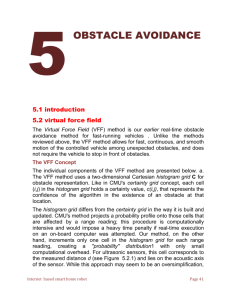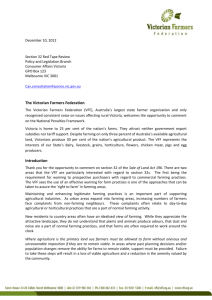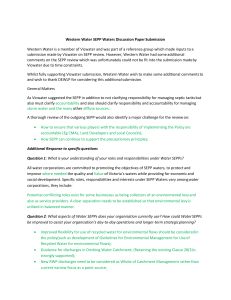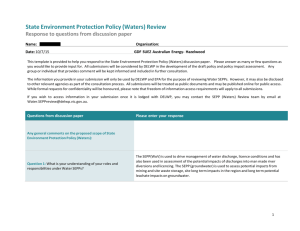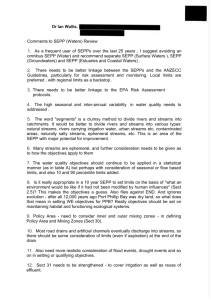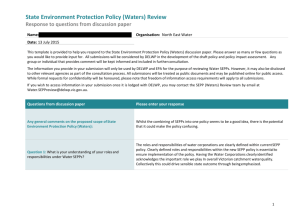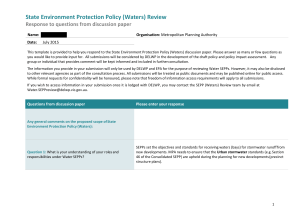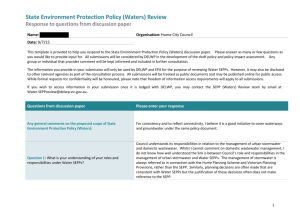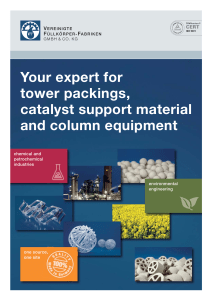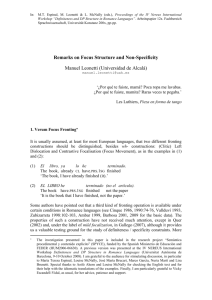Victorian Farmers Federation - Department of Environment, Land
advertisement
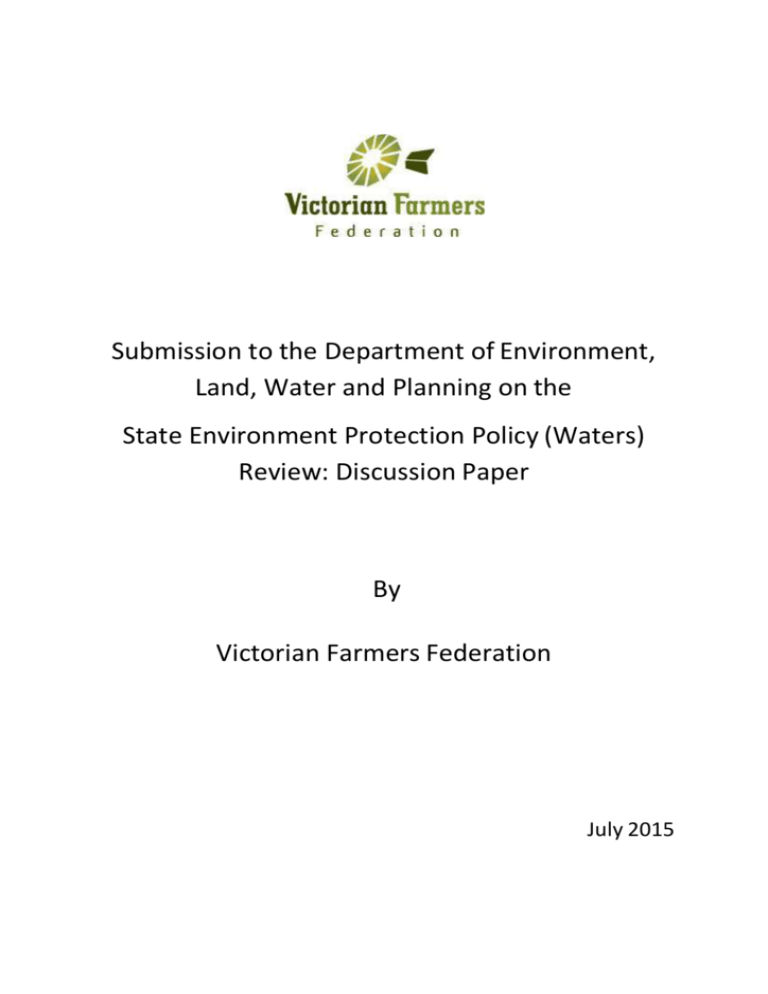
Submission to the Department of Environment, Land, Water and Planning on the State Environment Protection Policy (Waters) Review: Discussion Paper By Victorian Farmers Federation July 2015 Foreword The Victorian Farmers Federation (VFF) is Australia’s largest state farmer organisation, and the only recognised, consistent voice on issues affecting rural Victoria. The VFF consists of an elected Board of Directors, a member representative Policy Council to set policy and eight commodity groups representing dairy, grains, livestock, horticulture, chicken meat, pigs, flowers and egg industries. Farmers are elected by their peers to direct each of the commodity groups and are supported by Melbourne-based staff. Each VFF member is represented locally by one of the 230 VFF branches across the state and through their commodity representatives at local, district, state and national levels. The VFF also represents farmers’ views at many industry and government forums. Peter Tuohey President Page 2 of 10 Executive Summary The VFF is a key voice for Victorian irrigators and rural communities. We have a keen interest in the protection of water for use in agricultural production and also by farming families for domestic purposes. We welcome the opportunity to comment on the State Environment Protection Policy (Waters) Review. We have made the following specific recommendations in response to questions posed in the Discussion Paper: Recommendation 1 The VFF supports a clearer separation between feasible and aspirational and a sharper focus on the feasible to enable effective use of time, money and resources, helping to reduce the regulatory burden. (Question 4) Recommendation 2 The VFF suggests that the wording of the SEPP (Waters) objective needs to recognise the constraints of the timeframe and be consistent with the national strategy. (Question 5) Recommendation 3 The VFF supports the need to balance economic and social development with protection of water quality. The compounding effects of other policy changes in the water sector must be considered in SEPP implementation. (Question 6) Recommendation 4 The VFF supports more open and informed discussion about the trade-offs and how these are paid for. (Question 7) Recommendation 5 The VFF recommends that effluent ponds and tail areas for run-off from irrigation are water environments where it is not sensible to protect beneficial uses. (Question 9) Recommendation 6 The VFF supports a sub-segment for irrigation districts. (Question 13) Recommendation 7 The VFF strongly supports continued inclusion of agriculture, irrigation, stock watering and industrial/commercial as beneficial uses for rivers, wetlands/lakes and groundwater. (Question 14) Recommendation 8 The VFF supports a strategic approach to identifying opportunities and cost-effective solutions. (Question 15) Page 3 of 10 Recommendation 9 The VFF supports the use of locally derived information to develop tiered objectives. (Question 17) Recommendation 10 The VFF supports tailored locally developed solutions to at-risk areas. (Question 19) Recommendation 11 The VFF supports the collection of information to inform the future review of the SEPP (Waters). (Question 20) For enquiries about this submission please contact Page 4 of 10 Responses to key questions Question 4: What is the best way to reflect what is feasible versus what is aspirational in the context of a 10-year policy cycle? The VFF supports a clearer articulation of what is feasible and what is aspirational in the ten year time frame. The environmental objectives/indicators and attainment program need to be feasible in the ten year timeframe. This would provide greater certainty to industry and community and help manage expectations of what can be achieved. It will also enable government, industry and the community to allocate time, money and resources accordingly. This will help to reduce the regulatory burden on farmers. The key benefit of reviewing the SEPP (Waters) every ten years is the opportunity to consider changes in policy, science and values which will impact on the effectiveness of the policy. This means that within the ten year timeframe of the policy the focus can be on the feasible, as there will be a future opportunity to re-assess the policy. Recommendation 1 The VFF supports a clearer separation between feasible and aspirational and a sharper focus on the feasible to enable effective use of time, money and resources, helping to reduce the regulatory burden. Question 5: Do you support the proposed SEPP (Waters) objective of “this policy is to protect and improve the quality of Victoria’s water while providing for economic and social development”? Why? Whilst the VFF supports the inclusion of “improve” in the interests of broader water management, the ability of the SEPP (Waters) to deliver on this needs to be clearly articulated given the feasibility of what is achievable in a ten year timeframe with the available resources. The improvement of Victoria’s water quality is a long term goal, beyond the effective life of one individual SEPP (Waters). The Victorian Waterway Management Strategy: Improving Our Waterways recognises that the national policy context is provided by the National Water Quality Management Strategy (NWQMS). The objective of the NWQ MS is: “to achieve sustainable use of water resources, by protecting and enhancing their quality, while maintaining economic and social development.” The phrasing of the SEPP (Waters) objective should be consistent with this in so far as it relates to the role of the SEPP (Waters). The shift from ‘while maintaining’ to ‘providing for’ implies a shift in the underlying thinking. ‘While maintaining’ acknowledges that the economic and social development already exist and that any changes need to occur in this context and with consideration of the impacts. In contrast ‘while providing’ seems to create a hierarchy where the environmental value is higher than the economic and social use. The intent of the SEPP (Waters) is about finding the balance between the competing beneficial uses in different situations, whereas ‘while providing’ seems to prescribe an answer. Page 5 of 10 Recommendation 2 The VFF suggests that the wording of the SEPP (Waters) objective needs to recognise the constraints of the timeframe and be consistent with the national strategy. Question 6: Do you support the need to balance economic and social development with overall protection and improvement of water quality for Victoria’s water environments? Why? The VFF supports the need to balance economic and social development with protection of water quality. The Murray Darling Basin Plan recognises that we have water dependent communities and industries along our rivers. It is unreasonable to expect that the water in these working rivers can be returned to pristine quality. Finding the balance between the needs of the environment and the impact from economic and social development is important in ensuring that we will continue to have working rivers into the future. As population increases and the demand for food and fibre increases there will be greater pressure on our natural resources. We need to protect the ability of these resources to continue to support our needs. Victorian farmers are already facing reduced water availability as a result of programs to recover water for the environment. The reduced volume of water in the temporary pool and a dry spring has resulted in high prices. Whilst allocations for permanent entitlement holders have been good in recent years the inflows for the coming year are being projected on a dry scenario. Irrigators have less water in their carryover accounts because of the increased demand this year. The reduced water availability is increasing costs and may mean reduced production levels; resulting in downward pressure on farm viability. The compounding impact of further regulatory costs on farmers already under pressure needs to be taken into account. Recommendation 3 The VFF supports the need to balance economic and social development with protection of water quality. The compounding effects of other policy changes in the water sector must be considered in SEPP implementation. Question 7: What are the challenges of balancing economic and social development with protecting and improving water quality? How should we manage the appropriate trade-offs between them? The main challenge is the cost and agreeing on who pays the cost. The VFF supports the principle that “users of goods and services should pay prices based on the full life cycle costs of providing the goods and services, including costs relating to the use of natural resources and the ultimate disposal of wastes” (Policy principle 5c). However in the current market this does not happen. Farmers are price takers; they have no one to pass increased costs onto. Any change to the regulatory environment which increases the cost of doing business is squeezing the viability of farming families. The finances of local councils and catchment management authorities are already stretched. The cost implications of regulatory changes need to take into account the limited ability of farmers to absorb additional costs. Page 6 of 10 The cost of improving water quality needs to be balanced against the benefits this will deliver. Interventions which have a high cost-benefit ratio will need to be acceptable to the community which is expected to pay for them. The impact of interventions will need to be monitored to assess whether the benefits have been delivered, and at the expected cost. Government needs to be clearer and more transparent about what the potential trade-offs are, and once a decision has been made explain how and why the trade-offs were made. More discussion needs to be promoted to understand what exactly is being traded off when the environment is prioritised. Unpacking terms like economic and social development/impact to explore what this means for farming families and rural communities is important in contributing to an informed discussion about trade-offs. The VFF believes there is a need to educate the broader public about the role of working river systems that produce the food on their tables and the clothes in their wardrobes. Recommendation 4 The VFF supports more open and informed discussion about the trade-offs and how these are paid for. Question 9: Are there any specific types of water environments, for example, a wastewater treatment lagoon, where you think beneficial uses should not be protected? The VFF believes that on-farm effluent ponds and tail areas for run-off from irrigation are water environments where it is not appropriate to protect beneficial uses. These water environments are constructed specifically to deal with poor water quality. To apply the same water quality requirements is not logical. The VFF recognises that in proposing these exclusions the water in these environments must still be managed in such a way that it does not have unacceptable impacts on the beneficial uses of waterways or groundwater. Under the current SEPP (WoV) farmers have existing responsibilities to manage effluent and run-off from irrigation, including preventing it from entering waterways. This involves holding the effluent and tail water on-farm and re-using it. A whole farm plan will not be approved if it does not include a recycling system. The VFF supports further investment in programs which provide incentives for farmers to address water quality management on-farm. The VFF supports the use of recycled water of suitable quality being used in agriculture. Farmers in the Werribee Irrigation District and in the Eastern Irrigation Scheme are already using recycled water from the Western and Eastern Treatment Plants. The VFF has been working with farmers on the outskirts of Melbourne to identify routes for additional pipelines from the Eastern Treatment Plant and the Lilydale Treatment Plant to use recycled water for horticulture. Recommendation 5 The VFF recommends that effluent ponds and tail areas for run-off from irrigation are water environments where it is not sensible to protect beneficial uses. Page 7 of 10 Question 13: Are there any features of the landscape that you would like to see as a stand-alone segment or sub-segment? The VFF supports a sub-segment for irrigation districts. The factors which affect the use and quality of water in irrigation districts are primarily related to the beneficial use of agriculture. While point sources may be managed there may still be a risk to water quality in a waterway from the cumulative impact of farmers in the irrigation district. The value of working at the irrigation district level is already recognised. The rural water corporations already have institutional arrangements in place for engaging with customers in irrigation districts and in many districts there are existing plans for nutrient and salinity management. Creating a sub-segment for irrigation districts would help make it clearer to the broader public and other stakeholders how water quality issues are being managed by the agriculture sector. Recommendation 6 The VFF supports a sub-segment for irrigation districts. Question 14: Do you believe that all beneficial uses set out in Table 2 should still be protected under the new SEPP (Waters)? Where do you think a beneficial use would not apply? Why? The VFF strongly supports continued inclusion of agriculture, irrigation, stock watering and industrial/commercial as beneficial uses. Agriculture is water dependent, without water farmers cannot produce food. Agriculture is also a valuable contributor to the Victorian economy, producing food for domestic consumption and export. In 2012-13 the agricultural sector in Victoria was worth $11.6 billion. Industrial and commercial uses of water in the agriculture sector relate to food processing plants and intensive industries such as chicken meat, eggs and pigs. The VFF notes that in Table 2 the beneficial use for ‘agriculture and irrigation’ does not include a ‘Yes’ in the groundwater environment. Whilst the beneficial use for ‘agriculture, parks and gardens’ does include a ‘Yes’ in the groundwater environment. This could be addressed by separating agriculture from ‘parks and gardens’ and including a ‘Yes’ in the groundwater environment for ‘agriculture and irrigation’. Recommendation 7 The VFF strongly supports continued inclusion of agriculture, irrigation, stock watering and industrial/commercial as beneficial uses for rivers, wetlands/lakes and groundwater. Page 8 of 10 Question 15: What method or approach could be used to apply the beneficial uses to segments and sub-segments? The VFF believes it would be useful to take a strategic approach to applying beneficial uses to segments and sub-segments. This would involve identifying areas where a real difference could be made – either on the basis of where there is a significant opportunity or a problem which can be cost-effectively addressed. The Commonwealth and Victorian Water Holders have been established since the SEPP (WoV) and SEPP (GoV) were gazetted. Each year the environmental water holders develop annual watering plans to prioritise the use of their held water. There is an opportunity to consider leveraging the delivery of environmental water to assist with water quality interventions. Identifying areas where water quality issues can be solved at a reasonable cost will require a cost benefit analysis to establish whether and to what extent the benefits are likely to outweigh the costs. This is recognised good practice prior to making any investment, but it can also be used as a tool to compare one intervention with another and thus support strategic decision-making. Recommendation 8 The VFF supports a strategic approach to identifying opportunities and cost-effective solutions. Question 17: What do you think about the current indicators, the approach for deriving objectives and the proposed changes? The VFF supports the use of locally derived data to assist in building an understanding of what is feasible in a given area. Local data will be able to take account of factors which affect the water quality such as soil type, rainfall patterns, crop types and drainage infrastructure. Understanding the local situation will help build a picture of what actions are likely to be cost-effective. The VFF supports an approach for deriving objectives which acknowledges that many of Victoria’s rivers and streams are the basis of economic and social development for rural and regional communities and their livelihoods. Farmers are dependent on water to produce food and fibre for the rest of the population. The VFF supports the use of tiered objectives to assist in managing the competing beneficial uses. Recognising that some water environments have multiple uses and are therefore less likely to achieve water quality of a standard needed to protect all beneficial uses is important in setting expectations and priorities. The use of locally derived data and the creation of a sub-segment for irrigation districts would also assist in delivering a tiered objective approach. Recommendation 9 The VFF supports the use of locally derived information to develop tiered objectives. Page 9 of 10 Question 19: What is the preferred method for management of at-risk areas? Are there activities that need greater intervention or regulation? What would the intervention be, for example, voluntary or mandatory codes of practice, regulation via licensing? The VFF appreciates that there needs to be a process for identifying and monitoring at-risk areas. However we are concerned that using triggers based on objectives and indicators which are aspirational will create expectations and costs which cannot be met. The VFF believes there needs to be a clearer articulation of what is feasible and what is aspirational; see our response to Question 4. The VFF is concerned about applying one approach across all at-risk areas in the State. This would not allow for local circumstances to be effectively taken into account. The local factors contributing to the at-risk area need to be explored and solutions need to be appropriately matched to the problem, in terms of scale, cost and benefits. Developing a solution which is tailored to the problem creates a greater chance of success, rather than applying a blanket approach which may not effectively address the issue and may not be cost-effective in that situation. The VFF supports working with farmers, industry and local communities to build their understanding of the issues and discuss potential solutions in the local context. The VFF supports programs which provide incentives for change over added regulations. Recommendation 10 The VFF supports tailored locally developed solutions to at-risk areas. Question 20: What do you think the role of SEPP (Waters) should be in identifying and filling knowledge gaps over the life of the policy? How can we assure an adaptive approach within SEPP (Waters)? The VFF supports informed and timely decision-making. We recognise that the SEPP (Waters) will be made at a certain point in time and with regard to a set of circumstances that exist at that point in time. As the circumstances change it is likely that the effectiveness of the policy to respond will also change. An effective monitoring framework is needed in order to understand what these changes are and what the implications of these changes are. Knowledge gaps and emerging issues could be identified through this process. The regular review of the SEPP (Waters) provides a clear and transparent opportunity for the government, community and industry to then determine what actions are appropriate to address these gaps and issues. The ten year life of the policy seems a reasonable amount of time in which to monitor and observe the impact of changes. The VFF would be concerned if an adaptive approach resulted in changes being introduced without due process or due consideration of the evidence as this may result in creeping costs for farming communities. Recommendation 11 The VFF supports the collection of information to inform the future review of the SEPP (Waters). Page 10 of 10
